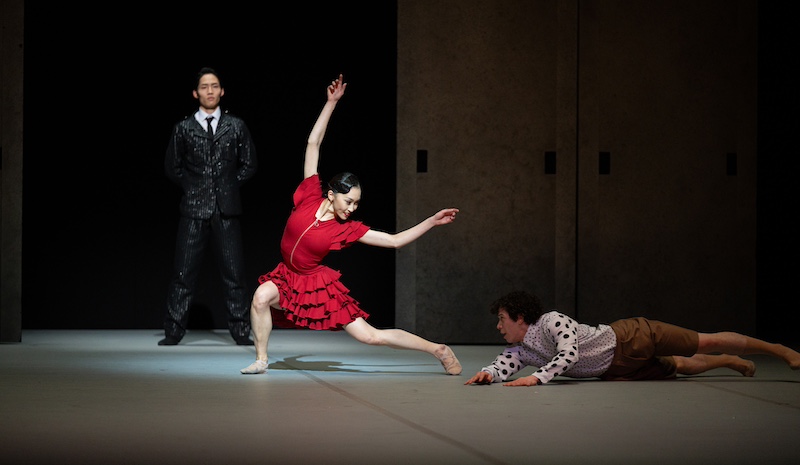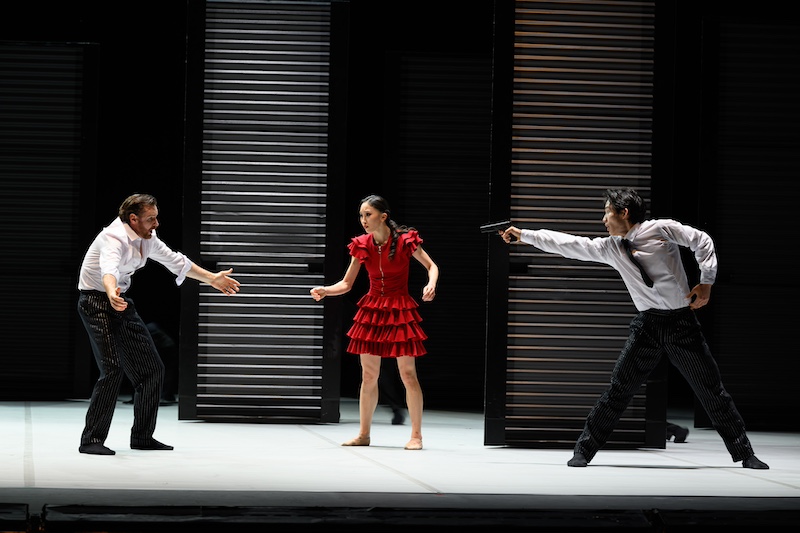The story of Carmen is catnip to choreographers. No matter how many times this 180-year-old narrative has been tweaked and reframed in art, theatre, opera, dance and film, they keep coming back for more – which is curious when you consider that Carmen began life in a saucy French novella read in smoking rooms and gentlemen’s clubs.
If it was fear of low-life women and racial contamination that made her provocative in the late 19th century, that hardly explains the persistence of Carmen into the 21st, nor the fact that two different full-evening dance versions are being presented at Sadler’s Wells within a matter of months.
English National Ballet’s Carmen, currently showing at the Wells, was made for Spain’s national dance company in 2015 by Stockholm-born Johan Inger. Its splay-limbed athleticism and jagged shape-shifting reflects his long association with Nederlands Dans Theatre, where he developed his choreographic language, and it suits ENB’s dancers very well – at least, they throw themselves at it with energy and pizzazz. As to the music, Inger’s version rejects the lush instrumentation of Bizet’s opera in favour of Rodion Schchedrin’s dry, sardonic 1967 treatment of the material, heavy on tuned percussion that gives an impression of rattling bones. Schchedrin’s suite is extended with electronic sequences by the Spanish composer Marc Alvarez, and the switching back and forth, from pre-recorded to live ENB Philharmonic in the pit, proves to be one of the more successful innovations of the evening. The production refocuses the action from Carmen to Don José, recalling the original novella which is narrated by Don José from his prison cell as he awaits the death sentence for Carmen’s murder, and in doing so it tries to make a point about male violence. But her off-the-scale sexual behaviour is a problem in this scheme. In its first half, Inger’s production seems to take the usual modern line which is that, as a poor woman, and a member of a racial underclass, the serial seduction of men is her only means to having agency in the world. Yet it doesn’t address why she rubs their noses in it, flaunting each new relationship in the face of the cast-off lover. Her gleeful advertising of her men as cuckolds goads them into reacting, and extremely. I don’t think we were meant to take sides, but I found myself increasingly sympathetic to Rentaro Nakaaki’s hapless Don José (pictured above and top), a middle-manager at the factory where Carmen works. He was only doing his job when he broke up a fight between Carmen and one of her fellow cigarreras, and his life fell into a death spiral from then on. That sympathy may also have been a result of Nakaaki’s lyrical, loose-limbed dancing. He was a joy to watch throughout.
The production refocuses the action from Carmen to Don José, recalling the original novella which is narrated by Don José from his prison cell as he awaits the death sentence for Carmen’s murder, and in doing so it tries to make a point about male violence. But her off-the-scale sexual behaviour is a problem in this scheme. In its first half, Inger’s production seems to take the usual modern line which is that, as a poor woman, and a member of a racial underclass, the serial seduction of men is her only means to having agency in the world. Yet it doesn’t address why she rubs their noses in it, flaunting each new relationship in the face of the cast-off lover. Her gleeful advertising of her men as cuckolds goads them into reacting, and extremely. I don’t think we were meant to take sides, but I found myself increasingly sympathetic to Rentaro Nakaaki’s hapless Don José (pictured above and top), a middle-manager at the factory where Carmen works. He was only doing his job when he broke up a fight between Carmen and one of her fellow cigarreras, and his life fell into a death spiral from then on. That sympathy may also have been a result of Nakaaki’s lyrical, loose-limbed dancing. He was a joy to watch throughout. As in Bizet’s opera, Carmen’s co-workers appear before she does, but in this case we’re not immediately struck by their poverty and downtroddenness – the short, flippy flamenco-frilled frocks designed for them by David Delfin make them look sassy and ready to party, equipped as they are front and back with zips that enable the women to shrug down the top half of the frock and work in their bras. This may have been a clever nod to the historic factory women’s rolling the cigars on their bare thighs, but ends up channeling Sporty Spice. The set of this Carmen makes you think of anywhere but southern Spain with its dour metal pillars, like tall grey filing cabinets, which are wheeled around to form factory walls, the bullring, the mountains, and the inside of poor Don José’s tormented mind. It's grim.
As in Bizet’s opera, Carmen’s co-workers appear before she does, but in this case we’re not immediately struck by their poverty and downtroddenness – the short, flippy flamenco-frilled frocks designed for them by David Delfin make them look sassy and ready to party, equipped as they are front and back with zips that enable the women to shrug down the top half of the frock and work in their bras. This may have been a clever nod to the historic factory women’s rolling the cigars on their bare thighs, but ends up channeling Sporty Spice. The set of this Carmen makes you think of anywhere but southern Spain with its dour metal pillars, like tall grey filing cabinets, which are wheeled around to form factory walls, the bullring, the mountains, and the inside of poor Don José’s tormented mind. It's grim.
Even the sex is unappealing, every encounter with Minju Kang's Carmen giving the impression of raptor and prey. And what I presume was a wink to female ejaculation barely registered when she squeezed an orange over a prostrate Don José after their steamy pas de deux. Moments of big drama are more effective: Don José's shooting (pictured above) of his line-manager Zuniga (James Streeter, horribly macho) has the slo-mo can't-believe-this-is-happening feel of a real-life assault. And the unraveling of Don José's mind, presented as an endless stream of everyone he has ever known, their corpses rolling like cigars on a conveyor belt across the stage, could have worked if it had cut out the silly screaming. Random vocalising is rarely effective in ballet, bad singing even worse. The corps' crooning along to the Toreador's march was flat as well as feeble.
The addition of a character billed as The Boy (but confusingly played by a girl with her hair in a plait), who observes the sexual goings-on from a distance, is clearly intended to make us think about how behaviours and attitudes are passed down from one generation to another. After Carmen's brutal death by stabbing, The Boy destroys a doll he has been playing with, ripping off its limbs and head. If clarity of messaging is what you're after, then this gets top marks. As theatre, it's un-nuanced verging on crass.














Add comment